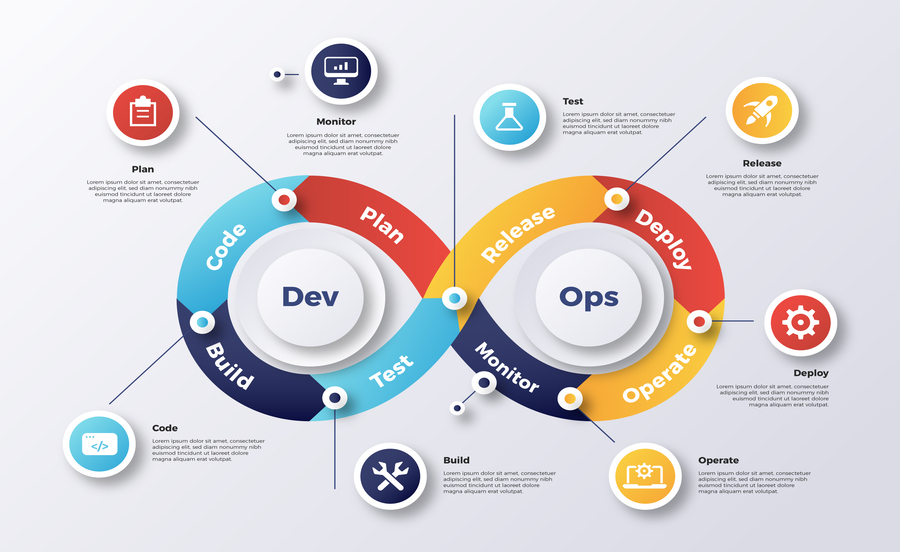
Introduction
In the ever-evolving landscape of software development and IT operations, DevOps has emerged as a transformative approach to bridge the gap between development and operations teams. It fosters collaboration, automation, and a culture of continuous improvement, enabling organizations to deliver high-quality software at a rapid pace. In this blog, we’ll delve into the world of DevOps, exploring its principles, practices, tools, and benefits.
What is DevOps?
DevOps, a portmanteau of “development” and “operations,” is a cultural and technical movement that aims to streamline the software delivery process. It emphasizes close collaboration between development, operations, and other stakeholders to achieve faster delivery, improved quality, and greater agility. At its core, DevOps encourages a shift from siloed, sequential workflows to cross-functional teams working together throughout the software lifecycle.
Key Principles of DevOps
- Collaboration: DevOps encourages open communication and collaboration between development, operations, QA, and other teams involved in the software delivery process.
- Automation: Automation plays a crucial role in DevOps, enabling teams to automate repetitive tasks such as testing, deployment, and infrastructure provisioning.
- Continuous Integration (CI) and Continuous Delivery (CD): CI/CD practices involve frequently integrating code changes into a shared repository and automating the deployment pipeline to deliver software releases quickly and reliably.
- Infrastructure as Code (IaC): IaC allows teams to manage infrastructure resources programmatically, treating infrastructure configuration as code to improve consistency, scalability, and efficiency.
- Monitoring and Feedback: DevOps promotes real-time monitoring of applications and infrastructure, enabling teams to gather feedback, identify issues, and make data-driven decisions for continuous improvement.
DevOps Practices and Tools
- Version Control: Git, SVN
- Continuous Integration: Jenkins, CircleCI, Travis CI
- Configuration Management: Ansible, Chef, Puppet
- Containerization: Docker, Kubernetes
- Orchestration: Kubernetes, Docker Swarm
- Infrastructure as Code: Terraform, AWS CloudFormation
- Monitoring and Logging: Prometheus, ELK Stack (Elasticsearch, Logstash, Kibana)
- Collaboration and Communication: Slack, Microsoft Teams
Benefits of DevOps:
- Accelerated Time-to-Market: DevOps enables faster delivery of features and updates, helping organizations respond to market demands more quickly.
- Improved Quality: By automating testing and deployment processes, DevOps reduces the risk of errors and enhances software quality.
- Increased Efficiency: Automation streamlines workflows, eliminates manual tasks, and improves overall operational efficiency.
- Enhanced Collaboration: DevOps fosters a culture of collaboration and shared responsibility, breaking down silos between teams and promoting cross-functional collaboration.
- Better Customer Satisfaction: With faster delivery cycles and higher-quality releases, DevOps ultimately leads to greater customer satisfaction and loyalty.
DevOps Culture: Building Bridges, Not Walls
DevOps isn’t just about tools and practices; it’s a cultural shift that encourages collaboration, transparency, and accountability across teams. Here’s how organizations can foster a DevOps culture:
Shared Goals and Ownership: Aligning development and operations teams around common goals fosters a sense of shared ownership. When everyone is working towards the same objectives, it eliminates the “us vs. them” mentality and promotes collaboration.
Continuous Learning and Improvement: Embrace a culture of continuous learning, where team members are encouraged to experiment, fail fast, and learn from mistakes. By promoting a blame-free environment, organizations can encourage innovation and rapid iteration.
Feedback Loops: Establish feedback loops at every stage of the software delivery process, from development and testing to deployment and operations. Regular feedback helps teams identify areas for improvement and make course corrections in real-time.
Cross-Functional Teams: Break down organizational silos by forming cross-functional teams that include members from development, operations, QA, security, and other relevant disciplines. This ensures that all perspectives are represented and promotes a holistic approach to problem-solving.
Leadership Support: Leadership plays a crucial role in driving cultural change. Leaders should champion the DevOps mindset, lead by example, and provide the necessary resources and support for teams to embrace DevOps principles and practices.
DevOps Automation: Empowering Teams to Do More with Less
Automation lies at the heart of DevOps, enabling teams to streamline repetitive tasks, reduce human error, and accelerate the software delivery process. Here are some key areas where automation can make a significant impact:
Continuous Integration and Deployment: Automate the process of building, testing, and deploying software releases using CI/CD pipelines. By automating these tasks, teams can deliver changes to production quickly and reliably, with minimal manual intervention.
Infrastructure Provisioning: Adopt Infrastructure as Code (IaC) tools like Terraform or AWS CloudFormation to automate the provisioning and configuration of infrastructure resources. This allows teams to treat infrastructure as code, version control it, and provision resources consistently across different environments.
Configuration Management: Use configuration management tools such as Ansible, Chef, or Puppet to automate the configuration and management of servers and application environments. This ensures consistency and repeatability across deployments, reducing the risk of configuration drift.
Monitoring and Alerting: Implement automated monitoring and alerting solutions to detect issues in real-time and notify the appropriate stakeholders. By proactively monitoring the health and performance of systems, teams can identify and address issues before they impact users.
Testing and Quality Assurance: Automate the execution of tests, including unit tests, integration tests, and end-to-end tests, as part of the CI/CD pipeline. Automated testing helps ensure software quality and provides fast feedback to developers, enabling them to iterate quickly.
Conclusion
In today’s competitive business environment, adopting DevOps practices is no longer optional—it’s essential for organizations striving to stay ahead of the curve. By embracing the principles of collaboration, automation, and continuous improvement, businesses can unleash the full potential of DevOps with ChetsApp to drive innovation, accelerate delivery, and deliver value to customers more effectively than ever before. Whether you’re a seasoned IT professional or a newcomer to the world of DevOps, understanding its principles and practices is key to navigating the modern landscape of software development and operations.

